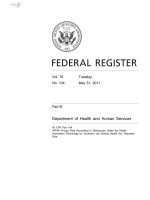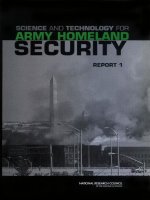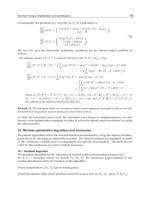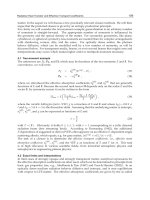INFORMATION TECHNOLOGY FOR COUNTERTERRORISM potx
Bạn đang xem bản rút gọn của tài liệu. Xem và tải ngay bản đầy đủ của tài liệu tại đây (41.74 MB, 146 trang )
Committee on the Role of Information Technology
in Responding to Terrorism
Computer Science and Telecommunications Board
John L. Hennessy, David A. Patterson, and Herbert S. Lin, Editors
THE NATIONAL ACADEMIES PRESS
Washington, D.C.
www.nap.edu
INFORMATION
TECHNOLOGY
FOR
COUNTERTERRORISM
IMMEDIATE ACTIONS AND FUTURE POSSIBILITIES
THE NATIONAL ACADEMIES PRESS • 500 Fifth Street, N.W. • Washington, DC 20001
NOTICE: This project was approved by the Governing Board of the National
Research Council, whose members are drawn from the councils of the National
Academy of Sciences, the National Academy of Engineering, and the Institute of
Medicine. The members of the committee responsible for this final report were
chosen for their special competences and with regard for appropriate balance.
The study from which this report is largely derived was supported by private
funds from the National Academies. The additional work required to produce
this report was supported by core funding from the Computer Science and Tele-
communications Board (CSTB). Core support for CSTB in this period was pro-
vided by the Air Force Office of Scientific Research, Department of Energy, Na-
tional Institute of Standards and Technology, National Library of Medicine,
National Science Foundation, Office of Naval Research, and the Cisco, Intel, and
Microsoft corporations. Sponsors enable but do not influence CSTB’s work. Any
opinions, findings, conclusions, or recommendations expressed in this publica-
tion are those of the authors and do not necessarily reflect the views of the organi-
zations or agencies that provide support for CSTB.
International Standard Book Number 0-309-08736-8
Library of Congress Control Number: 2003101593
Copies of this report are available from the National Academies Press, 500 Fifth
Street, N.W., Lockbox 285, Washington, DC 20055; (800) 624-6242 or (202) 334-
3313 in the Washington metropolitan area. Internet, .
Additional copies of this report are available in limited quantity from the Com-
puter Science and Telecommunications Board, National Research Council, 500
Fifth Street, N.W., Washington, DC 20001. Call (202) 334-2605 or e-mail the CSTB
at
Copyright 2003 by the National Academy of Sciences. All rights reserved.
Printed in the United States of America
Suggested citation: Computer Science and Telecommunications Board, Informa-
tion Technology for Counterterrorism: Immediate Actions and Future Possibilities, The
National Academies Press, Washington, D.C., 2003.
The National Academy of Sciences is a private, nonprofit, self-perpetuating soci-
ety of distinguished scholars engaged in scientific and engineering research, dedi-
cated to the furtherance of science and technology and to their use for the general
welfare. Upon the authority of the charter granted to it by the Congress in 1863,
the Academy has a mandate that requires it to advise the federal government on
scientific and technical matters. Dr. Bruce M. Alberts is president of the National
Academy of Sciences.
The National Academy of Engineering was established in 1964, under the charter
of the National Academy of Sciences, as a parallel organization of outstanding
engineers. It is autonomous in its administration and in the selection of its mem-
bers, sharing with the National Academy of Sciences the responsibility for advis-
ing the federal government. The National Academy of Engineering also sponsors
engineering programs aimed at meeting national needs, encourages education
and research, and recognizes the superior achievements of engineers. Dr. Wm. A.
Wulf is president of the National Academy of Engineering.
The Institute of Medicine was established in 1970 by the National Academy of
Sciences to secure the services of eminent members of appropriate professions in
the examination of policy matters pertaining to the health of the public. The
Institute acts under the responsibility given to the National Academy of Sciences
by its congressional charter to be an adviser to the federal government and,
upon its own initiative, to identify issues of medical care, research, and educa-
tion. Dr. Harvey V. Fineberg is president of the Institute of Medicine.
The National Research Council was organized by the National Academy of Sci-
ences in 1916 to associate the broad community of science and technology with
the Academy’s purposes of furthering knowledge and advising the federal gov-
ernment. Functioning in accordance with general policies determined by the
Academy, the Council has become the principal operating agency of both the
National Academy of Sciences and the National Academy of Engineering in pro-
viding services to the government, the public, and the scientific and engineering
communities. The Council is administered jointly by both Academies and the
Institute of Medicine. Dr. Bruce M. Alberts and Dr. Wm. A. Wulf are chair and
vice chair, respectively, of the National Research Council.
www.national-academies.org
iv
COMMITTEE ON THE ROLE OF INFORMATION TECHNOLOGY
IN RESPONDING TO TERRORISM
JOHN HENNESSY, Stanford University, Chair
DAVID A. PATTERSON, University of California at Berkeley, Vice Chair
STEVEN M. BELLOVIN, AT&T Laboratories
W. EARL BOEBERT, Sandia National Laboratories
DAVID BORTH, Motorola Labs
WILLIAM F. BRINKMAN, Lucent Technologies (retired)
JOHN M. CIOFFI, Stanford University
W. BRUCE CROFT, University of Massachusetts at Amherst
WILLIAM P. CROWELL, Cylink Inc.
JEFFREY M. JAFFE, Bell Laboratories, Lucent Technologies
BUTLER W. LAMPSON, Microsoft Corporation
EDWARD D. LAZOWSKA, University of Washington
DAVID LIDDLE, U.S. Venture Partners
TOM M. MITCHELL, Carnegie Mellon University
DONALD NORMAN, Northwestern University
JEANNETTE M. WING, Carnegie Mellon University
Staff
HERBERT S. LIN, Senior Scientist and Study Director
STEVEN WOO, Program Officer
DAVID DRAKE, Senior Project Assistant
v
COMPUTER SCIENCE AND TELECOMMUNICATIONS BOARD
2002-2003
DAVID D. CLARK, Massachusetts Institute of Technology, Chair
ERIC BENHAMOU, 3Com Corporation
DAVID BORTH, Motorola Labs
JOHN M. CIOFFI, Stanford University
ELAINE COHEN, University of Utah
W. BRUCE CROFT, University of Massachusetts at Amherst
THOMAS E. DARCIE, AT&T Labs Research
JOSEPH FARRELL, University of California at Berkeley
JOAN FEIGENBAUM, Yale University
HECTOR GARCIA-MOLINA, Stanford University
WENDY KELLOGG, IBM Thomas J. Watson Research Center
BUTLER W. LAMPSON, Microsoft Corporation
DAVID LIDDLE, U.S. Venture Partners
TOM M. MITCHELL, Carnegie Mellon University
DAVID A. PATTERSON, University of California at Berkeley
HENRY (HANK) PERRITT, Chicago-Kent College of Law
DANIEL PIKE, Classic Communications
ERIC SCHMIDT, Google Inc.
FRED SCHNEIDER, Cornell University
BURTON SMITH, Cray Inc.
LEE SPROULL, New York University
WILLIAM STEAD, Vanderbilt University
JEANNETTE M. WING, Carnegie Mellon University
Staff
MARJORY S. BLUMENTHAL, Executive Director
HERBERT S. LIN, Senior Scientist
ALAN S. INOUYE, Senior Program Officer
JON EISENBERG, Senior Program Officer
LYNETTE I. MILLETT, Program Officer
CYNTHIA A. PATTERSON, Program Officer
STEVEN WOO, Dissemination Officer
JANET BRISCOE, Administrative Officer
RENEE HAWKINS, Financial Associate
DAVID PADGHAM, Research Associate
KRISTEN BATCH, Research Associate
PHIL HILLIARD, Research Associate
MARGARET HUYNH, Senior Project Assistant
vi
DAVID DRAKE, Senior Project Assistant
JANICE SABUDA, Senior Project Assistant
JENNIFER BISHOP, Senior Project Assistant
BRANDYE WILLIAMS, Staff Assistant
For more information on CSTB, see its Web site at <http://www.
cstb.org>, write to CSTB, National Research Council, 500 Fifth Street,
N.W., Washington, DC 20001, call at (202) 334-2605, or e-mail at
vii
Preface
Immediately following the events of September 11, 2001, the National
Academies (including the National Academy of Sciences, the National
Academy of Engineering, the Institute of Medicine, and the National Re-
search Council) offered its services to the nation to formulate a scientific
and technological response to the challenges posed by emerging terrorist
threats that would seek to inflict catastrophic damage on the nation’s
people, its infrastructure, or its economy. Specifically, it supported a
project that culminated in a report entitled Making the Nation Safer: The
Role of Science and Technology in Countering Terrorism (The National Acad-
emies Press, Washington, D.C.) that was released on June 25, 2002. That
project, chaired by Lewis M. Branscomb and Richard D. Klausner, sought
to identify current threats of catastrophic terrorism, understand the most
likely vulnerabilities in the face of these threats, and identify highly lever-
aged opportunities for contributions from science and technology to coun-
terterrorism in both the near term and the long term.
Taking the material on information technology contained in Making
the Nation Safer as a point of departure, the Committee on the Role of
Information Technology in Responding to Terrorism, identical to the
Panel on Information Technology that advised the Branscomb-Klausner
committee, drew on sources, resources, and analysis unavailable to that
committee during the preparation of its report. In addition, the present
report contains material and elaborations that the Branscomb-Klausner
committee did not have time to develop fully for the parent report. Both
reports are aimed at spurring research in the science and technology com-
viii PREFACE
munities to counter and respond to terrorist acts such as those experi-
enced on September 11.
In addition to presenting material on information technology (IT),
Making the Nation Safer includes chapters on nuclear and radiological
threats, human and agricultural health systems, toxic chemicals and ex-
plosive materials, energy systems, transportation systems, cities and fixed
infrastructure, and the response of people to terrorism. The present
report focuses on IT—its role as part of the national infrastructure, sug-
gested areas of research (information and network security, IT for emer-
gency response, and information fusion), and the people and organiza-
tional aspects that are critical to the acceptance and use of the proposed
solutions. Note that policy is not a primary focus of this report, although
policy issues are addressed as needed to provide context for the research
programs outlined here.
Information Technology for Counterterrorism draws on many past re-
ports and studies of the Computer Science and Telecommunications Board
(CSTB). These CSTB reports include Cybersecurity Today and Tomorrow:
Pay Now or Pay Later; Computers at Risk: Safe Computing in the Information
Age; Embedded, Everywhere: A Research Agenda for Networked Systems of
Embedded Computers; Realizing the Potential of C4I: Fundamental Challenges;
Information Technology Research for Crisis Management; and Computing and
Communications in the Extreme, among others. Furthermore, the report
leverages current CSTB studies on geospatial information, authentication
technologies, critical infrastructure protection and the law, and privacy.
The Committee on the Role of Information Technology in Respond-
ing to Terrorism included current and past CSTB members as well as
other external experts. The 16 committee members (see the appendix for
committee and staff biographies) are experts in computer, information,
Internet, and network security; computer and systems architecture; com-
puter systems innovation, including interactive systems; national security
and intelligence; telecommunications, including wireline and wireless;
data mining and information fusion and management; machine learning
and artificial intelligence; automated reasoning tools; information-pro-
cessing technologies; information retrieval; networked, distributed, and
high-performance systems; software; and human factors. To meet its
charge, the committee met several times over a 2-month period and con-
ducted extensive e-mail dialogue to discuss the report text.
As was the parent report, this focused report was developed quickly,
with the intent of informing key decision makers with respect to the role
of information technology in the homeland security effort. The treatment
of any of the subjects in this report is far from comprehensive or exhaus-
tive—instead, the report highlights those subject aspects that the commit-
tee deems critical at this time. Accordingly, the report builds on, and cites
ixPREFACE
heavily, prior CSTB reports that more substantially address the relevant
issues.
The committee wishes to thank the CSTB staff (Herbert Lin as study
director, Steven Woo for research support, and D.C. Drake for adminis-
trative support) for developing coherent drafts from scraps of e-mail and
brief notes from committee meetings.
John L. Hennessy, Chair
David A. Patterson, Vice Chair
Committee on the Role of Information Technology
in Responding to Terrorism
xi
Acknowledgment of Reviewers
This report has been reviewed in draft form by individuals chosen for
their diverse perspectives and technical expertise, in accordance with pro-
cedures approved by the National Research Council’s (NRC’s) Report
Review Committee. The purpose of this independent review is to pro-
vide candid and critical comments that will assist the institution in mak-
ing the published report as sound as possible and to ensure that the report
meets institutional standards for objectivity, evidence, and responsive-
ness to the study charge. The review comments and draft manuscript
remain confidential to protect the integrity of the deliberative process.
We wish to thank the following individuals for their participation in the
review of this report:
Edward Balkovich, The RAND Corporation,
Richard Baseil, The MITRE Corporation,
Jules A. Bellisio, Telcordia,
Tom Berson, Anagram Laboratories,
James Gray, Microsoft,
Daniel Huttenlocher, Cornell University,
Richard Kemmerer, University of California at Santa Barbara,
Keith Marill, New York University Bellevue Hospital Center,
William Press, Los Alamos National Laboratory,
Fred Schneider, Cornell University, and
Edward Wenk, University of Washington.
xii ACKNOWLEDGMENT OF REVIEWERS
Although the reviewers listed above provided many constructive
comments and suggestions, they were not asked to endorse the conclu-
sions or recommendations, nor did they see the final draft of the report
before its release. The review of this report was overseen by R. Stephen
Berry of the University of Chicago. Appointed by the NRC’s Report
Review Committee, he was responsible for making certain that an inde-
pendent examination of this report was carried out in accordance with
institutional procedures and that all review comments were carefully con-
sidered. Responsibility for the final content of this report rests entirely
with the Computer Science and Telecommunications Board and the Na-
tional Research Council.
xiii
Contents
EXECUTIVE SUMMARY 1
1 BACKGROUND AND INTRODUCTION 10
1.1 What Is Terrorism?, 10
1.2 The Role of Information Technology in National Life
and in Counterterrorism, 11
1.3 The Information Technology Infrastructure and
Associated Risks, 12
2 TYPES OF THREATS ASSOCIATED WITH
INFORMATION TECHNOLOGY INFRASTRUCTURE 15
2.1 Attack on IT as an Amplifier of a Physical Attack, 15
2.2 Other Possibilities for Attack Involving IT, 16
2.2.1 Attacks on the Internet, 16
2.2.2 Attacks on the Public Switched Network, 18
2.2.3 The Financial System, 20
2.2.4 Embedded/Real-Time Computing, 20
2.2.5 Control Systems in the National Critical
Infrastructure, 21
2.2.6 Dedicated Computing Facilities, 23
2.3 Disproportionate Impacts, 23
2.4 Threats in Perspective: Possibility, Likelihood,
and Impact, 24
xiv CONTENTS
3 INVESTING IN INFORMATION TECHNOLOGY RESEARCH 28
3.1 Information and Network Security, 31
3.1.1 Authentication, 33
3.1.2 Detection, 35
3.1.3 Containment, 37
3.1.4 Recovery, 40
3.1.5 Cross-cutting Issues in Information and Network
Security Research, 41
3.2 Systems for Emergency Response, 46
3.2.1 Intra- and Interoperability, 47
3.2.2 Emergency Deployment of Communications
Capacity, 55
3.2.3 Security of Rapidly Deployed Ad Hoc Networks, 57
3.2.4 Information-Management and Decision-Support
Tools, 58
3.2.5 Communications with the Public During an
Emergency, 59
3.2.6 Emergency Sensor Deployment, 60
3.2.7 Precise Location Identification, 61
3.2.8 Mapping the Physical Aspects of the
Telecommunications Infrastructure, 62
3.2.9 Characterizing the Functionality of Regional Networks
for Emergency Responders, 62
3.3 Information Fusion, 63
3.3.1 Data Mining, 68
3.3.2 Data Interoperability, 69
3.3.3 Natural Language Technologies, 69
3.3.4 Image and Video Processing, 70
3.3.5 Evidence Combination, 70
3.3.6 Interaction and Visualization, 71
3.4 Privacy and Confidentiality, 71
3.5 Other Important Technology Areas, 75
3.5.1 Robotics, 75
3.5.2 Sensors, 76
3.5.3 Simulation and Modeling, 78
3.6 People and Organizations, 80
3.6.1 Principles of Human-Centered Design, 81
3.6.2 Organizational Practices in IT-Enabled
Companies and Agencies, 89
3.6.3 Dealing with Organizational Resistance to Interagency
Cooperation, 91
xvCONTENTS
3.6.4 Principles into Practice, 93
3.6.5 Implications for Research, 95
4 WHAT CAN BE DONE NOW? 97
5 RATIONALIZING THE FUTURE RESEARCH AGENDA 106
APPENDIX: BIOGRAPHIES OF COMMITTEE AND
STAFF MEMBERS 115
WHAT IS CSTB? 127
1
Executive Summary
Making the Nation Safer: The Role of Science and Technology in Countering
Terrorism, a report released by the National Academies in June 2002,
1
articulated the role of science and technology in countering terrorism.
That report included material on the specific role of information tech-
nology (IT). Building on that report as a point of departure, the panel of
experts responsible for the IT material in Making the Nation Safer was
reconvened as the Committee on the Role of Information Technology in
Responding to Terrorism in order to develop the present report.
DEFINING TERRORISM FOR THE PURPOSES OF THIS REPORT
Terrorism can occur on many different scales and with a wide range
of impacts. While a terrorist act can involve a lone suicide bomber or a
rental truck loaded with explosives, Americans’ perception of catastrophic
terrorist acts will forever be measured against the events of September 11,
2001. In one single day, thousands of lives and tens of billions of dollars
were lost to terrorism. This report focuses primarily on the high-impact
catastrophic dimensions of terrorism as framed by the events of Septem-
ber 11. Thus, in an IT context, the “lone hacker,” or even the cyber-
criminal—while bothersome and capable of doing damage—is not the
focus of this report. Instead, the report considers the larger threat posed
1
National Research Council. 2002. Making the Nation Safer: The Role of Science and Tech-
nology in Countering Terrorism. The National Academies Press, Washington, D.C.
2 INFORMATION TECHNOLOGY FOR COUNTERTERRORISM
by smart, disciplined adversaries with ample resources. (Of course,
measures taken to defend against catastrophic terrorism will likely have
application in defending against less sophisticated attackers.)
THE ROLE OF INFORMATION TECHNOLOGY IN
SOCIETY AND IN COUNTERTERRORISM
Information technology is essential to virtually all of the nation’s criti-
cal infrastructures, from the air-traffic-control system to the aircraft them-
selves, from the electric-power grid to the financial and banking systems,
and, obviously, from the Internet to communications systems. In sum,
this reliance of all of the nation’s critical infrastructures on IT makes any
of them vulnerable to a terrorist attack on their computer or telecommu-
nications systems.
An attack involving IT can take different forms. The IT itself can be
the target. Or, a terrorist can either launch or exacerbate an attack by
exploiting the IT infrastructure, or use IT to interfere with attempts to
achieve a timely response. Thus, IT is both a target and a weapon. Like-
wise, IT also has a major role in counterterrorism—it can prevent, detect,
and mitigate terrorist attacks. For example, advances in information fusion
and data mining may facilitate the identification of important patterns of
behavior that help to uncover terrorists or their plans in time to prevent
attacks.
While there are many possible scenarios for an attack on some
element(s) of the IT infrastructure (which includes the Internet, the tele-
communications infrastructure, embedded/real-time computing such as
SCADA [supervisory control and data acquisition] systems, and dedi-
cated computing devices such as desktop computers), the committee
believes that the most devastating consequences would occur if an attack
on or using IT were part of a multipronged attack with other, more physi-
cal components. In this context, compromised IT could expand terrorist
opportunities to widen the damage of a physical attack, diminish timely
responses to the attack, and heighten terror in the population by provid-
ing false information about the nature of the threat.
The likelihood of a terrorist attack against or through the use of the IT
infrastructure must be understood in the context of terrorists. Like other
organizations, terrorist groups are likely to utilize their limited resources
in activities that maximize impact and visibility. A decision by terrorists
to use IT, or any other means, in an attack depends on factors such as the
kinds of expertise and resources available, the publicity they wish to gain,
and the symbolic value of an attack. How terrorists weigh such factors is
not known in advance. Those wanting to create immediate public fear
3EXECUTIVE SUMMARY
and terror are more likely to use a physical attack than an attack that
targets IT exclusively.
WHAT CAN BE DONE NOW:
SHORT-TERM RECOMMENDATIONS
The committee makes two short-term recommendations with respect
to the nation’s communications and information systems.
Short-Term Recommendation 1: The nation should develop a pro-
gram that focuses on the communications and computing needs of emer-
gency responders. Such a program would have two essential compo-
nents:
• Ensuring that authoritative, current-knowledge expertise and sup-
port regarding IT are available to emergency-response agencies
prior to and during emergencies, including terrorist attacks.
• Upgrading the capabilities of the command, control, communica-
tions, and intelligence (C3I) systems of emergency-response agen-
cies through the use of existing technologies. Such upgrades might
include transitioning from analog to digital systems and deploying
a separate emergency-response communications network in the
aftermath of a disaster.
Short-Term Recommendation 2: The nation should promote the use
of best practices in information and network security in all relevant public
agencies and private organizations.
• For IT users on the operational level: Ensure that adequate informa-
tion-security tools are available. Conduct frequent, unannounced
red-team penetration testing of deployed systems. Promptly fix
problems and vulnerabilities that are known. Mandate the use of
strong authentication mechanisms. Use defense-in-depth in addi-
tion to perimeter defense.
• For IT vendors: Develop tools to monitor systems automatically for
consistency with defined secure configurations. Provide well-
engineered schemes for user authentication based on hardware
tokens. Conduct more rigorous testing of software and systems for
security flaws.
• For the federal government: Position critical federal information sys-
tems as models for good security practices. Remedy the failure of
the market to account adequately for information security so that
appropriate market pro-security mechanisms develop.
4 INFORMATION TECHNOLOGY FOR COUNTERTERRORISM
WHAT CAN BE DONE IN THE FUTURE
Because the possible attacks on the nation’s IT infrastructure vary so
widely, it is difficult to argue that any one type is more likely than others.
This fact suggests the value of a long-term commitment to a strategic
research and development program that will increase the overall robust-
ness of the computer and telecommunications networks. Such a program
could improve the nation’s ability to prevent, detect, respond to, and
recover from terrorist attacks. This agenda would also have general appli-
cations, such as reducing cybercrime and responding to natural disasters.
Three critical areas of research are information and network security, C3I
systems for emergency response, and information fusion. Although tech-
nology is central to these three areas, it is not the sole element of concern.
Research in these areas must be multidisciplinary, involving technolo-
gists, social scientists, and domain experts. Since technology deployed
for operational purposes is subject to the reality of implementation and
use by humans, technology cannot be studied in isolation from how it is
deployed and used.
Information and Network Security
Research in information and network security is relevant to the nation’s
counterterrorism efforts for several reasons. IT attacks can amplify the
impact of physical attacks and lessen the effectiveness of emergency
responses. IT attacks on SCADA systems could be devastating. The
increasing levels of social and economic damage caused by cybercrime
suggest a corresponding increase in the likelihood of severe damage
through cyberattacks. The technology discussed here is relevant to fight-
ing cybercrime and to conducting efforts in defensive information warfare.
Research in information and network security can be grouped in four
areas: authentication, detection, containment, and recovery; a fifth set of
topics such as dealing with buggy code is broadly applicable.
• Authentication is relevant to better ways of preventing unautho-
rized parties from gaining access to a computer system to cause harm.
• Detection of intruders with harmful intentions is critical for thwart-
ing their actions. However, because intruders take great care to hide their
entry and/or make their behavior look innocuous, such detection is a
very challenging problem (especially when the intruder is an insider gone
bad).
• Containment is necessary if the success of an attacker is to be limited
in scope. Although the principle of graceful degradation under attack is
well accepted, system and network design for graceful degradation is not
well understood.
5EXECUTIVE SUMMARY
• Recovery involves backup and decontamination. In a security con-
text, backup methods for use under adversarial conditions and applicable
to large systems are needed. Decontamination—the process of distin-
guishing the clean system state from the infected portions and eliminat-
ing the causes of those differences—is especially challenging when a sys-
tem cannot be shut down.
• Other areas. Buggy code (i.e., flawed computer programs) is prob-
ably the oldest unsolved problem in computer science, and there is no
particular reason to think that research can solve the problem once and
for all. One approach to the problem is to provide incentives to install
fixes, even though the fixes themselves may carry risks such as exposing
other software flaws. Many system vulnerabilities result from improper
administration, and better system administration tools for specifying secu-
rity policies and checking system configurations are necessary. Research
in tools for auditing functionality to ensure that hardware and software
have the prescribed—and no additional—functionality would be helpful.
Security that is more transparent would have higher adoption rates. Under-
standing the failure in the marketplace of previous attempts to build in
computer security would help guide future research efforts.
IT and C3I for Emergency Response
C3I systems are critical to emergency responders for coordinating
their efforts and increasing the promptness and effectiveness of their
response. C3I for emergency response to terrorist attacks poses chal-
lenges that differ from natural disasters: the number of responding agen-
cies—from local, state, and federal governments—increases the degree of
complexity, while the additional security or law-enforcement presence
that is required may interfere with rescue and recovery operations.
C3I systems for emergency responders face many challenges:
• Regarding ad hoc interoperability, different emergency responders
must be able to communicate with each other and other agencies, and
poor interoperability among responding agencies is a well-known prob-
lem. Thus, for example, there is a technical need for protocols and tech-
nology that can facilitate interconnection and interoperation.
• Emergency situations result in extraordinary demands on commu-
nications capacity. Research is needed on using residual capacity more
effectively and deploying additional (“surge”) capacity.
• In responding to disasters, emergency-response managers need
decision-support tools that can assist them in sorting, evaluating, filtering,
and integrating information from a vast array of voice and data traffic.
• During an emergency, providing geographically sensitive public
6 INFORMATION TECHNOLOGY FOR COUNTERTERRORISM
information that is relevant to where people are (e.g., for evacuation pur-
poses) is a challenging technical problem.
• Sensors deployed in an emergency could track the spread of nuclear or
biological contaminants, locate survivors (e.g., through heat emanations
or sounds), and find pathways through debris.
• Location identification of people and structures is a major problem
when there is physical damage to a structure or an area.
Information Fusion
Information fusion promises to play a central role in the prevention,
detection, and response to terrorism. For example, the effectiveness of
checkpoints such as airline boarding gates could be improved signifi-
cantly by creating information-fusion tools to support checkpoint opera-
tors in real time (a prevention task). Also, advances in the automatic
interpretation of image, video, and other kinds of unstructured data could
aid in detection. Finally, early response to biological attacks could be
supported by collecting and analyzing real-time data such as admissions
to hospital emergency rooms and purchases of nonprescription drugs in
grocery stores. The ability to acquire, integrate, and interpret a range and
volume of data will support decision makers such as emergency-response
units and intelligence organizations.
Data mining is a technology for analyzing historical and current online
data to support informed decision making by learning general patterns
from a large volume of specific examples. But to be useful for counter-
terrorist purposes, such efforts must be possible over data in a variety of
different and nonstructured formats, such as text, image, and video in
multiple languages. In addition, new research is needed to normalize and
combine data collected from multiple sources to improve data inter-
operability. And, new techniques for data visualization will be useful in
exploiting human capabilities for pattern recognition.
Privacy and Confidentiality
Concerns over privacy and confidentiality are magnified in a counter-
terrorism intelligence context. The perspective of intelligence gatherers,
“collect everything in case something might be useful,” conflicts with the
pro-privacy tenet of “don’t collect anything unless you know you need
it.” To resolve this conflict, research is needed to provide policy makers
with accurate information about the impact on privacy and confidentiality
of different kinds of data disclosure. Furthermore, the development of
new privacy-sensitive techniques may make it possible to provide useful
information to analysts without compromising individual privacy. A va-
7EXECUTIVE SUMMARY
riety of policy actions could also help to reduce the consequences of pri-
vacy violations.
Other Important Technology Areas
This report also briefly addresses three other technology areas: robotics,
sensors, and modeling and simulation:
• Robots, which can be used in environments too dangerous for human
beings, combine complex mechanical, perceptual, and computer and tele-
communications systems, and pose significant research challenges such
as the management of a team of robots and their integration.
• Sensors, used to detect danger in the environment, are most effec-
tive when they are linked in a distributed sensor network, a problem that
continues to pose interesting research problems.
• Modeling and simulation can play important roles throughout crisis-
management activities by making predictions about how events might
unfold and by testing alternative operational choices. A key challenge is
understanding the utility and limitations of models hastily created in
response to an immediate crisis.
People and Organizations
Technology is always used in some social and organizational context,
and human culpability is central in understanding how the system might
succeed or fail. The technology cannot be examined in isolation from how
it is deployed. Technology aimed at assisting people is essential to modern
everyday life. At the same time, if improperly deployed, the technology
can actually make the problem worse; human error can be extremely
costly in time, money, and lives. Good design can dramatically reduce
the incidence of error.
Principles of Human-Centered Design
Systems must be designed from a holistic, systems-oriented perspec-
tive. Principles that should guide such design include the following:
• Put human beings “in the loop” on a regular basis. Systems that use
human beings only when automation is incapable of handling a situation
are invariably prone to “human error.”
• Avoid common-mode failures, and recognize that common modes are not
always easy to detect.
• Observe the distinction between work as prescribed and work as practiced.









